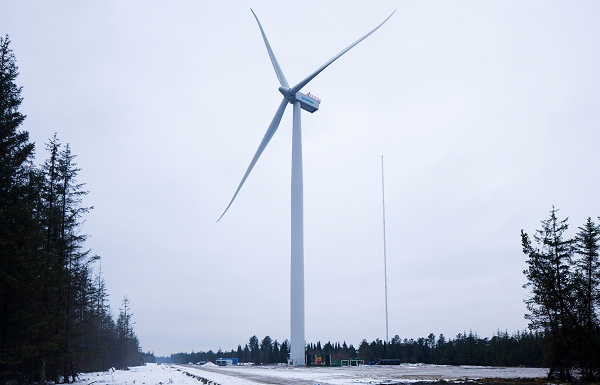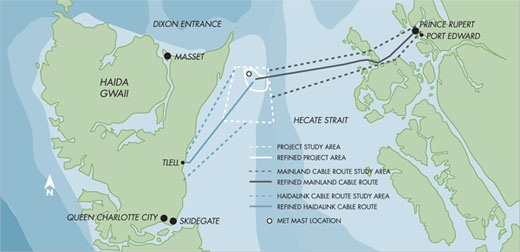BC Offshore Wind Signs Up Siemens, and Hopes
The United States isn’t the only North American country lagging on offshore wind power. While Europe had 1,502 turbines with a generating capacity of 4,336 megawatts connected to the grid as of June 30, Canada, like the U.S., was still at zero.
Much of the offshore attention in Canada has been focused on Lake Ontario, where Windstream Energy’s 130-turbine, 300-megawatt (MW) Wolfe Island Shoals project was stalled by Ontario’s moratorium on offshore wind. But there’s a project way out west, as well – a 400-MW array planned for the Hecate Strait off British Columbia’s north coast – that is at desperately trying to put all the pieces of the puzzle in place.

Prototype of new Siemens 4-megawatt offshore wind turbine, installed at a test site in Denmark. (image via Siemens)
Late last week, NaiKun Wind Energy Group announced a preferred supplier deal with the Canadian arm of Siemens. The deal would put to work the Germany-based energy giant’s new 4-MW turbine – an upgrade on the widely used SWT-3.6 – that Siemens is now promoting after installing a prototype in Denmark. But this is a project that has been talked about for at least sixyears, and has run into some significant hurdles.
NaiKun says it is “at an advanced stage of development with environmental approvals from the Provincial and Federal Governments and agreements in place with key suppliers and First Nations,” but what it doesn’t have is a customer for its power. According to a CBC report, in 2010 the public utility BC Hydro rejected the NaiKun project as a clean power supplier, alluding to cost questions as well as “excessive risk.” The project also suffered a blow in late 2011 when Haida Nation voters rejected an agreement to become investors in the project.

The area NaiKun is eying is between Haida Gwaii (formerly known as the Queen Charlotte Islands) and Prince Rupert, 465 miles north of Vancouver as the crow flies. Naikun Wind claims the strait there offers “unquestionably one of the best and largest wind resources in the world.” The company says the wind resource is particularly valuable because it blows strongest in the winter, “when BC electricity demand is highest and BC’s hydro resources are lowest.”
As usual with such projects, NaiKun makes a long-term energy production argument for building the wind array – clean energy capable of powering 130,000 homes – and it touts the shorter-term economic stimulus the project would provide, including 500 jobs during construction “and more than $400 million in direct expenditures in the province during construction, of which $250 million will benefit North Coast communities.”
Much of the offshore attention in Canada has been focused on Lake Ontario, where Windstream Energy’s 130-turbine, 300-megawatt (MW) Wolfe Island Shoals project was stalled by Ontario’s moratorium on offshore wind. But there’s a project way out west, as well – a 400-MW array planned for the Hecate Strait off British Columbia’s north coast – that is at desperately trying to put all the pieces of the puzzle in place.

Prototype of new Siemens 4-megawatt offshore wind turbine, installed at a test site in Denmark. (image via Siemens)
Late last week, NaiKun Wind Energy Group announced a preferred supplier deal with the Canadian arm of Siemens. The deal would put to work the Germany-based energy giant’s new 4-MW turbine – an upgrade on the widely used SWT-3.6 – that Siemens is now promoting after installing a prototype in Denmark. But this is a project that has been talked about for at least sixyears, and has run into some significant hurdles.
NaiKun says it is “at an advanced stage of development with environmental approvals from the Provincial and Federal Governments and agreements in place with key suppliers and First Nations,” but what it doesn’t have is a customer for its power. According to a CBC report, in 2010 the public utility BC Hydro rejected the NaiKun project as a clean power supplier, alluding to cost questions as well as “excessive risk.” The project also suffered a blow in late 2011 when Haida Nation voters rejected an agreement to become investors in the project.

The area NaiKun is eying is between Haida Gwaii (formerly known as the Queen Charlotte Islands) and Prince Rupert, 465 miles north of Vancouver as the crow flies. Naikun Wind claims the strait there offers “unquestionably one of the best and largest wind resources in the world.” The company says the wind resource is particularly valuable because it blows strongest in the winter, “when BC electricity demand is highest and BC’s hydro resources are lowest.”
As usual with such projects, NaiKun makes a long-term energy production argument for building the wind array – clean energy capable of powering 130,000 homes – and it touts the shorter-term economic stimulus the project would provide, including 500 jobs during construction “and more than $400 million in direct expenditures in the province during construction, of which $250 million will benefit North Coast communities.”
You can return to the main Market News page, or press the Back button on your browser.

